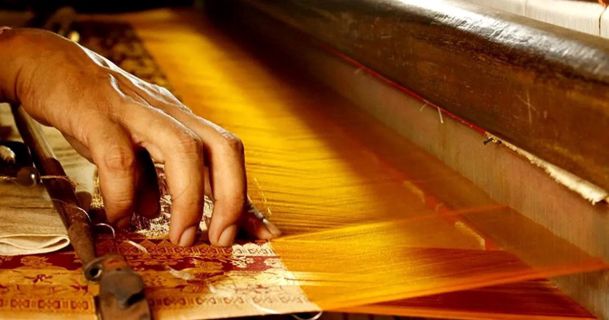
Silk has been famous for centuries. Middle eastern textile manufacturing and their business was a major commerce hub before the Islamic era. Eastern Mediterranean ports were the medium of transportation of the silk trade system from Asia to Europe. These different marketplaces were the centers of textile manufacturing. The Islamic authority holds the textile industry of Sasanian and Byzantine during the seventh and ninth centuries.

When Islam came into existence, their ancestors started influencing the textile industry and soon developed their silk fabric and other popular cloth material. Because of the tremendous demand from the middle eastern textile industry in medieval Europe, This marketplace became more popular than in Europe. The wide textile industry inherited from Arabic, Persian, and Turkish including phrases like taffeta, damask, muslin, and mohair becomes the link between European and Islamic textiles.
Lightweight silk
Islamic textile production factories started production of Lampas, compound wills and compound wills, and brocades as well as double and triple clothes. Patterns were highly stylish and were available at different times and locations. Simpler woven like satin and taffeta and also the different ranges of ultra silk fabric also played a significant role in it. Silk fabric started covering the cotton weft to make an expensive silk fabric. In the satin weave, silk fabric was visible on the fabric’s face and soon reversed. soon the Islamic males start using silk fabric and it became popular.
Tiraz
This silk fabric was popular from the eleventh to the fourteenth century and was distinctive. Tiraz fabric started becoming popular due to its embroidery and inscription borders. In addition to Baghdad, various other kings financed it throughout the world. This list includes Yemen, Syria, Egypt, and Moorish Spain. The upper sleeve with border became famous and looks good on the body of the garment too. Ceremonials and shrouds also adorn this fabric. The king’s palace walls have the present ruler’s name and religious phrases. High court officials wore this fabric and claimed themselves as honorific robes.
In the 8th century, compound woven silk factories and Tiraz workshops came into the limelight. It was after the Moorish conquest of Spain. Soon Spanish started making Islamic themes on fabrics. The theme included stylish floral designs and geometric patterns. Contrasting colors were existing in Spanish textiles which had a wide range of designs.
Ottoman Silk
From the fourteenth century, Bursa became the Ottoman empire’s significant silk for manufacturing. It was the one producing high-quality silk fabrics. Silk fabric became popular for its large-scale designs and vibrant colors in the Ottoman empire. Ottoman textile affected the Italian silk design which was not surely always the case. A large number of such designs showed Ottoman miniature paintings and tile designs. Three concentric circles are the frequent design element with wavy lines. The Ottoman repertory has some other parts known as Voided velvet and other complex weaves. People started liking fine silk embroidery on velvet, linen, cotton, and silk.
Exquisite silk and Persian textiles
In the Islamic world, Safavid Iran produced some of the finest silk in the world. There were some popular Islamic hubs in different centuries like Yazad in the fifteenth century, Isfahan in the sixteenth century, and Kashan in the seventeenth century. Persian silk was famous due to voided velvets, beautiful needlework, and sophisticated compound weaving. Miniature painting was employed in Persian textiles which use different human and animal figures in different poses. Persian fabric was also known for its silk embroidery and plain georgette fabric was also popular among people.
Dupion Silk
This fabric is a plain look but tightly woven double thread silk with a crisp appearance. It is woven in different-sized weft and warp threads that make a strong, durable fabric with a lustrous shine. Notice that the occasional black speck can run through the weave and it is a part of the original cocoon silk warm. This silk has plenty of charm and character that gives an iridescent look by weaving two different threads such as shot silk. The dupion is best used in bridal wear, jackets, elegant dresses, and evening dresses. People have a love of silk wear and it is a comfortable fabric for all weather conditions making it an ideal choice for all ages of people.
Conclusion
Silk has been popular in the textile world since ancient times. During historical times, it was considered the royal fabric but now it is in high demand by all types of people. Apart from silk, more fabrics like seersucker, cotton, and georgette material like georgette fabric are also popular. If you are looking for a great silk fabric supplier that is popular these days, you can easily find it online and can make deals. You can order all types of fabrics and different blend art online today.
Follow Nihu Sharma to stay updated on their latest posts!
0 comments
Be the first to comment!
This post is waiting for your feedback.
Share your thoughts and join the conversation.
